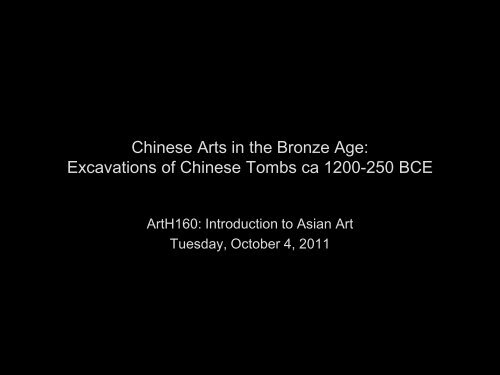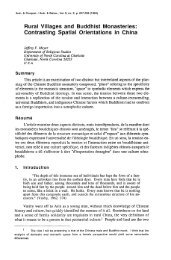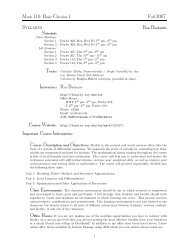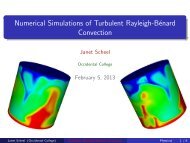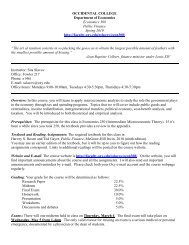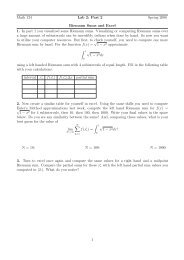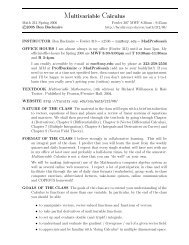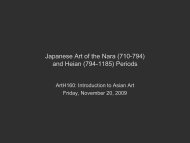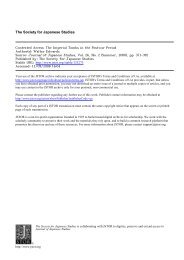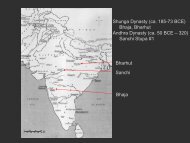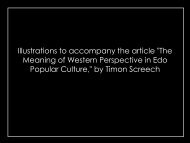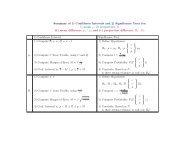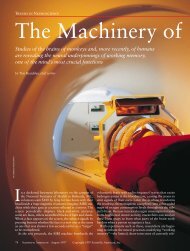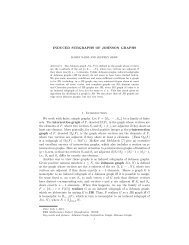Early Chinese Art: Tombs of the Shang Dynasty
Early Chinese Art: Tombs of the Shang Dynasty
Early Chinese Art: Tombs of the Shang Dynasty
You also want an ePaper? Increase the reach of your titles
YUMPU automatically turns print PDFs into web optimized ePapers that Google loves.
<strong>Chinese</strong> <strong>Art</strong>s in <strong>the</strong> Bronze Age:<br />
Excavations <strong>of</strong> <strong>Chinese</strong> <strong>Tombs</strong> ca 1200-250 BCE<br />
<strong>Art</strong>H160: Introduction to Asian <strong>Art</strong><br />
Tuesday, October 4, 2011
Beijing<br />
Yellow River<br />
Xi'an<br />
<strong>Shang</strong>hai<br />
Yangtze River
"Ancestor Worship"
What happens after death
<strong>Shang</strong> <strong>Dynasty</strong><br />
ca. 1700-1050 BCE<br />
Last capital at Anyang
<strong>Tombs</strong> <strong>of</strong> <strong>Shang</strong> Kings near Anyang<br />
ca 1300-1050 BCE
Ding found near Anyang in 1939<br />
H. 52.3"<br />
L. 43"<br />
Wt. 1836.5 lbs<br />
The four-legged bronze cauldron Simuwu Ding,<br />
discovered in 1939, is <strong>the</strong> world's biggest<br />
bronze ware item ever excavated
Ding found near Royal <strong>Tombs</strong> in 1939<br />
How does this vessel relate to Wu<br />
Hung's article on "monumentality" in<br />
<strong>Chinese</strong> art<br />
Why would Wu say it is "monumental"<br />
Although it is not one <strong>of</strong> <strong>the</strong> "Nine<br />
Tripods," how does it embody <strong>the</strong>ir<br />
qualities Is what crucial respects is it<br />
different<br />
Monumentality "denotes memory,<br />
continuity, and political, ethical, or<br />
religious obligations to a tradition" (Wu,<br />
p. 204)<br />
H. 52.3"<br />
L. 43"<br />
Wt. 1836.5 lbs
The taotie Motif on <strong>Shang</strong> Ritual Bronze Vessels
Piece-mold Casting
Tomb <strong>of</strong> Lady Fu Hao at Anyang<br />
Died ca. 1200 BCE<br />
Tomb discovered 1976
Tomb <strong>of</strong> Fu Hao at Anyang<br />
Died ca. 1200 BCE<br />
Tomb chamber ca. 26’ 3” deep<br />
18’ long x 13’ wide
Contents <strong>of</strong> Fu Hao's Tomb<br />
• 468 bronze objects including 130 weapons, 23 bells, 27 knives, 4<br />
mirrors, and 4 tigers or tiger heads<br />
• 755 jade objects<br />
• 63 stone objects<br />
• 5 ivory objects<br />
• 564 bone objects including nearly 500 bone hairpins and over 20<br />
bone arrowheads<br />
• 11 pottery objects<br />
• 6,900 pieces <strong>of</strong> cowry shell<br />
• Skeletons <strong>of</strong> 6 dogs, 16 humans<br />
From Visual Sourcebook for <strong>Chinese</strong> Civilization<br />
(http://depts.washington.edu/chinaciv/archae/2tommain.htm)
Some Bronze Vessels from Fu Hao's Tomb<br />
h. 31 ⅜"<br />
wt. 258 ½ lb. h. 26 ¼"<br />
wt. 42 lb.<br />
h. 20 ¼"<br />
wt. 37 lbs<br />
h. 18 ⅛"<br />
wt. 36 lb 12 oz
Bronze Covered Pouring Vessel (gong)<br />
Late <strong>Shang</strong> (Anyang Phase), ca. 1100 BCE<br />
composite animal form
Bronze pouring vessel (guang), tomb <strong>of</strong> Fu Hao, ca. 1200 BCE<br />
(vs. Bull seal from Indus Valley, ca. 2000 BCE)<br />
h. 14 ⅛”<br />
w. 18 lb 11 oz h. 1 ½"
Jade Elephant from Fu Hao’s tomb<br />
h. 1¼”<br />
h. 1 ¼"<br />
l. 2 ½"<br />
wt. 2 ¾ oz
Jade and Ivory Carvings from Fu Hao's Tomb<br />
h. 6 ½"<br />
h. 4"<br />
h. 2 1/8"<br />
l. 3 ¼" h. 2 ¾"<br />
h. 4 ⅞"
h. 6 ½"<br />
h. ca. 6"<br />
Indus Valley Civ,<br />
ca. 1500 BCE<br />
h. 4 ⅞"
l. 5½”<br />
Axe blade, perhaps used in<br />
ritual sacrifice, Tomb <strong>of</strong> Fu Hao<br />
Late <strong>Shang</strong> (Anyang)<br />
ca. 1200 BCE
h. 15 ½" w. 19 4/5 lb.<br />
Axe-head from Fu Hao Tomb
Oracle Bones from Royal Cemetery at Anyang<br />
Late <strong>Shang</strong>, ca. 1200-1050 BCE
Oracle Bones from Royal Cemetery at Anyang<br />
Late <strong>Shang</strong>, ca. 1200-1050 BCE
China in <strong>the</strong> Zhou <strong>Dynasty</strong><br />
(c. 1050-480 BCE)<br />
Confucius (ca. 551-479 BCE)<br />
[Buddha ca. 563-483 BCE]
<strong>Shang</strong> vs. Western Zhou<br />
<strong>Shang</strong>: ca. 1100 BCE<br />
W. Zhou, ca. 10 th century BCE


